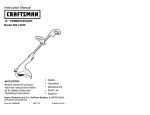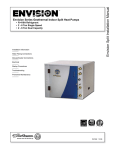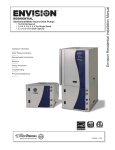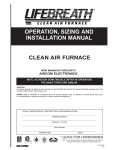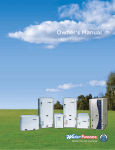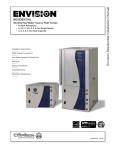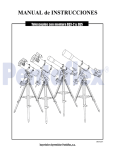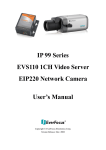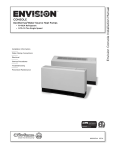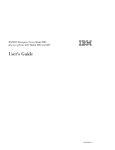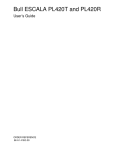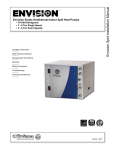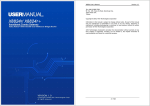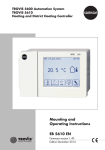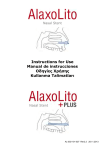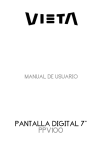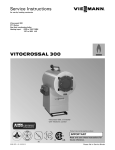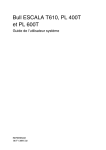Download Synergy3D Installation Manual W aterFurnace
Transcript
Installation Information Water Piping Connections Synergy3D Installation Manual Geothermal Heat Pumps with Water Heating for Radiant Floor Applications • 3 thru 6 Ton Electrical Connections Startup Procedures IM1602 04/08 WaterFurnace Preventive Maintenance SYNERGY3D INSTALLATION MANUAL Table of Contents Model Nomenclature 2 General Installation Information 3-5 Closed Loop Systems 6 Open Loop Systems 7 Buffer Tank Installation 8 Electrical 9 Thermostat Installation 10 Physical Data 11 Dimensional Data 12 Microprocessor Control Operation 13-15 Operating Limits 16 Correction Factors 17 Auxiliary Heat 18 Blower Performance & Auxilary Heat Data 19 Startup Checklist 20 Startup/Troubleshooting Form 21-23 1 SYNERGY3D INSTALLATION MANUAL Model Nomenclature S D V 049 A 1 1 1 N T Model Type S= Synergy3D Dual Capacity L Return Air Configuration L= Left R= Right Compressor Type D= Daul Capacity Discharge Air Configuration T= Top Cabinet Configuration V= Vertical Coax Options C= Copper N= Cupronickel Unit Capacity Fan Option 1= ECM 2= Oversized ECM Blower Option (038 & 049) Vintage A= Vintage Voltage 1= 208/230/60/1 Hot Water Option 0= None 1= Hot Water Generation with factory installed pump 2 SYNERGY3D INSTALLATION MANUAL General Installation Information Safety Considerations Installation and servicing of heating and air conditioning equipment can be hazardous due to system pressure and electrical components. Only trained and qualified service personnel should install, repair or service heating and air conditioning equipment. Untrained personnel can perform basic maintenance functions of cleaning coils and cleaning and replacing filters. All other operations should be performed by trained service personnel. When working on air conditioning equipment, observe precautions in the literature, tags and labels attached to the unit and other safety precautions that may apply. Follow all safety codes. Wear safety glasses and work gloves. Use quenching cloth for brazing operations. Have fire extinguisher available for all brazing operations. WARNING: Before performing service or maintenance operations on the system, turn off main power switches to the unit. Turn off accessory heater power switch if applicable. Electrical shock could cause serious personal injury. Moving and Storage Move units in the normal “Up” orientation. Vertical units are not to be moved, but may be stored one upon another to a maximum height of two units. When the equipment is received, all items should be carefully checked against the bill of lading to be sure all crates and cartons have been received. Examine units for shipping damage, removing the units from the packaging if necessary. Units in question should also be internally inspected. If any damage is noted, the carrier should make the proper notation on the delivery receipt, acknowledging the damage. Unit Location Locate the unit in an indoor area that allows easy removal of the filter and access panels, and has enough space for service personnel to perform maintenance or repair. Provide sufficient room to make water, electrical and duct connection(s). If the unit is located in a confined space, such as a closet, provisions must be made for return air to freely enter the space by means of a louvered door, etc. Care should be taken when units are located in unconditioned spaces to prevent damage from frozen water lines and excessive heat that could damage electrical components. CAUTION: A minimum of 24-inch clearance should be allowed for access to front access panel. Setting Vertical Units Vertical units are available in left or right hand return configuration. Vertical units should be mounted level on a vibration absorbing pad slightly larger than the base to provide isolation between the unit and the floor. It is not necessary to anchor the unit to the floor (See Figure 1). Duct System Figure 1: Vertical Unit Mounting Vibration Absorbing Mesh An air outlet collar is provided on vertical top flow units to facilitate a duct Air Pad connection, which is shipped inside the unit. A flexible connector is recommended for discharge and return air duct connections on metal duct systems. Uninsulated duct should be insulated with a minimum of 1-inch duct insulation. Application of the unit to uninsulated ductwork in an unconditioned space is not recommended as the unit’s performance will be adversely affected. If the unit is connected to existing ductwork, a previous check should have been made to assure that the duct has the capacity to handle the air required for the unit application. If ducting is too small, as in the replacement of heating only systems, larger ductwork should be installed. All existing ductwork should be checked for leaks and repaired when necessary. The duct system should be sized to handle the design airflow quietly. To maximize sound attenuation of the unit blower, the supply and return plenums should include internal duct liner of glass fiber or be of ductboard construction for the first few feet. If air noise or excessive airflow is a problem, the blower speed can be changed. See the Blower Performance and Fan Speed sections on page 16. 3 SYNERGY3D INSTALLATION MANUAL General Installation Information (cont.) Water Piping Connections Figure 2: Female Locking Ring All Synergy3D source water connections are swivel piping fittings that accept a 1-inch Male Pipe Thread (MPT) (see Figure 2). The swivel pipe connector has a rubber gasket seal similar to a garden hose gasket, which when mated to the flush end of 1-inch threaded pipe provides a leak-free seal without the need for thread sealing tape or compound. Check to ensure that the rubber seal is in the swivel connector prior to attempting any connection. The rubber seals are shipped attached to the air coil inside the blower compartment. To make the connection to a ground loop system, mate the brass connector (supplied in CK4L and CK4L-GL connector kits) against the rubber gasket in the swivel connector, and thread the female locking ring onto the pipe threads, while maintaining the brass connector in the desired direction (see Figure 2). Tighten the connectors by hand and then gently snug the fitting with pliers to provide a leak proof joint. When connecting to an open loop (ground water) system, thread 1inch MPT fitting into the swivel connector and tighten in the same manner as noted above. The open and closed loop piping system must include pressure/temperature taps for serviceability. Never use flexible hoses smaller than 1-inch inside diameter on the unit and limit hose length to 10 feet. per connection. Check carefully for water leaks. CAUTION: Water piping exposed to outside temperature may be subject to freezing. Water Quality Stainless Steel Snap Ring Gasket Material Locking Ring Gasket Support Sleeve Note: Load side fittings are same type as source. In ground water situations where scaling could be heavy or where biological growth such as iron bacteria will be present, a closed loop system is recommended. The heat exchanger coils in ground water systems may, over a period of time, lose heat exchange capabilities due to a buildup of mineral deposits inside. These can be cleaned, but only by a qualified service mechanic, as special solutions and pumping equipment are required. Desuperheater coils can likewise become 4 SYNERGY3D INSTALLATION MANUAL General Installation Information (cont.) scaled and possibly plugged. In areas with extremely hard water, the owner should be informed that the heat exchanger may require occasional flushing. Units with cupronickel heat exchangers are recommended for open loop applications due to the increased resistance to build-up and corrosion, along with reduced wear caused by acid cleaning. Freeze Sensing Set the freeze sensing switch SW2 #2 to “Loop” on the printed circuit board for applications using a closed loop antifreeze solution. On applications using an open loop/ground water system, set to “Well” (the factory setting). If using closed loop and no antifreeze solution leave in “Well” position (the factory setting). Condensate Drain The internal condensate drain assembly consists of a drain tube, which is attached to the drain pan, a 3/4-inch PVC female adapter, and a flexible connecting hose. The female adapter may exit either the front or the side of the vertical cabinet. The adapter will be glued to the field-installed PVC condensate piping. A condensate hose is inside all cabinets as a trapping loop; therefore, an external trap is not necessary. Air Coil To obtain maximum performance the air coil should be cleaned before start up. A 10% solution of dishwasher detergent and water is recommended for both sides of coil; a thorough water rinse should follow. 5 SYNERGY3D INSTALLATION MANUAL Closed Loop Ground Source Systems Once piping is completed between the unit, flow center and the ground loop (Figure 3), final purging and charging of the loop is needed. A flush cart (at least a 1.5 HP pump) is needed to achieve adequate flow velocity in the loop to purge air and dirt particles from the loop itself. Antifreeze solution is used in most areas to prevent freezing. Flush the system adequately to remove as much air as possible then pressurize the loop to a static pressure of 50-75 psi (winter) or 40-50 psi (summer). This is normally adequate for good system operation. Loop static pressure will fluctuate with the seasons. Pressures will be higher in the winter months than during the cooling season. This fluctuation is normal and should be considered when charging the system initially. After pressurization, be sure to remove the plug in the end of the loop pump motor(s) (if Grundfos® pumps are used) to allow trapped air to be discharged and to ensure the motor housing has been flooded. Ensure the loop flow center provides adequate flow through the unit by checking pressure drop across the heat exchanger and comparing it to the figures shown in unit capacity tables in Specification Catalog SP1554. Usually 2.5-3 gpm of flow per ton of cooling capacity is recommended in earth loop applications. See wiring schematics on pages 10 and 11 for loop pump power wiring details. Figure 3 - Closed Loop: Ground Source Application Unit Supply Auxiliary Heat Supply GeoLink Polyethylene w/ Armaflex Flexible Duct Collar TO LOOP GeoLink Flow LPK Center* Auxiliary Heater Knockout External Pump Power Disconnects (If Applicable) Drain * For complete GeoLink Flow Center installation information refer to IM1961 Connector Kits with Armaflex Low Voltage to Thermostat P/T Plugs Unit Power Vibration Absorbing Pad Multiple Units on One Flow Center When two Synergy3D units or one Envision unit and one Synergy3D unit are connected to one loop pumping system, pump control is automatically achieved by connecting the slave terminals on connector P2 in both units with 2-wire thermostat wire. These terminals are polarity conscious (see Figure 5). The loop pump(s) may be powered from either unit, whichever is more convenient. If either unit calls, the loop pump(s) will automatically start. 6 SYNERGY3D INSTALLATION MANUAL Open Loop Ground Water Systems Typical open loop piping is shown in Figure 5. Always maintain water pressure in the heat exchanger by placing water contraol valves at the outlet of hte unit to prevent mineral precipitation. Use a closed, bladder-type expansion tank to minimize mineral formation due to air exposure. Ensure proper water flow through the unit by checking pressure drip across the heat exchanger and comparing it to the figures in the pressure drop tables. Normally about 2 GPM flow rate per ton of cooling capacity (1.5 GPM per ton minimum at 50° F) is needed in open loop systems. Discharge water from the unit is not contaminated in any manner and can be disposed of in various ways such as recharge well, storm sewer, drain field, adjacent stream or pond, etc.depending on local building codes. Most local codes forbid the use of sanitary sewer for disposal. Consult your local building and zoning department to ensure compliance in your area. Figure 5 - Open System: Ground Water Application Aux. Heat Supply Unit Supply Flexible Duct Collar Rubber Bladder Expansion Tank Auxiliary Heater Knockout Flow Regulator Disconnects (If Applicable) Solenoid Valve Water Out Drain Water In Shut Off Valves Unit Power Low Voltage to Thermostat and Valve Shut-Off Valve (to isolate solenoid valve while acid flushing) Strainer P/T Plugs Boiler Drains For HX Flushing Vibration Absorbing Pad Notes: For open loop ground water systems or systems that do not contain and antifreeze solution, set SW2-#2 to the “Well” position. Figure 6: Open Loop Solenoid Valve Connection Option Figure 7: BPV or PPV Valve Wiring Typical slow operating external 24V water solenoid valve (type VM) wiring. Typical external 24V water solenoid valves (type PPV100, BPV100) wiring. Violet(2) CC VM valve CC Comfort Alert Blk(1) CC CC-GND Comfort Alert Y1 Wht(4) CC Blk(1) CC-GND SS Violet(3) Y2 Violet(2) CCHI Logic Board 7 Violet(3) Y1 Y2 Wht(4) CCHI Logic Board SYNERGY3D INSTALLATION MANUAL Desuperheater Connections To maximize the benefits of the desuperheater a minimum 50-gallon water heater is recommended. For higher demand applications, use an 80-gallon water heater or two 50-gallon water heaters connected in a series as shown below. Electric water heaters are recommended. Make sure all local electrical and plumbing codes are met for installing a desuperheater. The Synergy3D is not supplied with an internal circulator. A DPK5 kit will need to be purchased to connect to the desuperheater. The DPK5 kit is supplied with installation instructions. Typical Buffer Tank Installation Figure 8: Synergy3D with Buffer Tank 6=B 1=:2 !"Þ2][SabWQ !"Þ2][SabWQ Þ1]\\SQbW]\a Þ 4>B EObS`4c`\OQS 3<D7A7=< 8 SYNERGY3D INSTALLATION MANUAL Electrical General Be sure the available power is the same voltage and phase as that shown on the unit serial plate. Line and low voltage wiring must be done in accordance with local codes or the National Electric Code, whichever is applicable. Figure 9: Synergy3D Line Voltage 208-230/60/1 Unit Power Connection Line Voltage connection is made by connecting the incoming line voltage wires to the “L” side of the contactor as shown in Figure 9. Consult the Unit Electrical Data table below for correct fuse size. External Loop Pump Power Connection If the unit is to be used with an external loop pump (FC1 or FC2 flow center), the pump(s) will be connected to the terminals on PB1 in the unit electrical box as shown in Figure 4. The pumps will automatically be cycled as required by the unit or by a secondary signal from another Synergy3D unit sharing the flow center. (Refer to the wiring schematic on page 10-11.) L2 L1 208 Volt Operation All 208-230 volt units are factory wired for 230 volt operation. For 2098 volt operation, the red and the blue transformer wires must be switched on terminal strip PS1. (Refer to wiring schematic on pages 10-11 for details.) Figure 10: Wiring Multiple Units to One Flow Center Synergy3D Unit #1 Shut Down C C SL1 In With pump wired to Unit 1 Shut Down C C SL1 In R Y O G L S C VX, VL SL1 not not Out used used Coil With pump wired to Unit 2 24v Normally Open Contacts SL1 not not Out used used Shut Down Envision or Synergy3D Unit #2 C SL1 In C SL1 not not Out used used Synergy3D Unit #1 Electrical Data Model Rated Voltage Voltage Min/Max SDV038 SDV038* SDV049 SDV049* SDV064 SDV072 208-230/60/1 208-230/60/1 208-230/60/1 208-230/60/1 208-230/60/1 208-230/60/1 197/254 197/254 197/254 197/254 197/254 197/254 MCC RLA LRA Int Pump FLA 26.0 26.0 33.0 33.0 40.0 42.5 16.6 16.6 21.1 21.1 25.6 27.2 82.0 82.0 96.0 96.0 118.0 150.0 1.75 1.75 1.75 1.75 1.75 1.75 Compressor * With optional 1 HP ECM2 motor Ext Loop FLA Fan Motor FLA Total Unit FLA Min Circ Amp Max Fuse calc Max Fuse/ HACR 5.4 5.4 5.4 5.4 5.4 5.4 4.0 7.0 4.0 7.0 7.0 7.0 27.8 30.8 32.3 35.3 39.8 41.4 31.9 34.9 37.5 40.5 46.2 48.2 48.5 51.5 58.6 61.6 71.8 75.4 45 50 50 60 70 70 3/18/08 Rated Voltage of 208-230/60/1. Min/Max Voltage of 197/254. HACR circuit breaker in USA only. All fuses Class RK-5. Local electrical codes overule any wiring recommendations. 9 SYNERGY3D INSTALLATION MANUAL Thermostat Installation Installation Position the thermostat subbase against the wall so that it is level and the thermostat wires protrude through the subbase. Mark the position of the subbase mounting holes and drill holes with a 3/16-inch bit. Install anchors and secure base to the wall. Thermostat wire must be 8 conductor 18 AWG wire. Strip the wires back 1/4-inch (longer strip lengths may cause shorts) and insert the thermostat wires into the Synergy3D connector as shown in Figure 11. Tighten the screws to ensure good connections. The thermostat has the same type of connectors, requiring the same wiring. See instructions enclosed in the thermostat for detailed installation and operation information. Figure 11 - Thermostat Wiring 24VAC C 24VAC (Common) Y1 Compressor W Aux. Heat O Reversing Valve G Blower Relay L1 System Monitor (Hot) Thermostat Connection Synergy3D Microprocessor Controller R Other Thermostats The Synergy3D unit is compatible with virtually any 24VAC thermostat. However, the multi-stage nature of this product requires a 3-stage heating/2-stage cooling type thermostat. Note: DIP switch SW2-8 is required to be in the “OFF” position for the control to operate with FaultFlash or ComforTalk thermostats. SW2-8 in the “ON” position configures the control to operate with typical thermostats (continuous lockout signal). There must be a wire connecting Y2 on the microprocessor controller to 2nd stage compressor on the thermostat for proper operation. 10 SYNERGY3D INSTALLATION MANUAL Physical Data Model 038 049 Compressor (1 each) Factory Charge R410a, oz [kg] 064 072 Copeland Scroll 90 [2.55] 95 [2.69] 124 [3.51] 128 [3.62] ECM Fan Motor & Blower Fan Motor Type/Speeds Fan Motor- hp [W] Blower Wheel Size (Dia x W), in. [mm] ECM Variable Speed 1/2 [373] 11 x 10 [279 x 254] 1/2 [373] 11 x 10 [279 x 254] 1 [746] 1 [746] 11 x 10 [279 x 254] 11 x 10 [279 x 254] Coax and Water Piping Loop Water Connections Size - Swivel - in [mm] 1" [25.4] 1" [25.4] 1" [25.4] 1" [25.4] Hydronic Water Connections Size - Swivel - in [mm] 1" [25.4] 1" [25.4] 1" [25.4] 1" [25.4] HWG Connection Size - Swivel - in [mm] 1" [25.4] 1" [25.4] 1" [25.4] 1" [25.4] Coax & Piping Water Volume - gal [l] 1.3 [4.9] 1.6 [6.1] 1.6 [6.1] 1.6 [6.1] Air Coil Dimensions (H x W), in. [mm] 28 x 25 [711 x 635] 32 x 25 [813 x 635] 36 x 25 [914 x 635] 36 x 25 [914 x 635] Air Coil Total Face Area, ft2 [m2] 4.9 [0.451] 5.6 [0.570] 6.3 [0.641] 6.3 [0.641] 3/8 [9.5] 3/8 [9.5] 3/8 [9.5] 3/8 [9.5] 3 3 4 4 Vertical Air Coil Tube Size, in [mm] Air Coil Number of rows Filter Standard - 2" [51mm] Pleated MERV11 Throwaway, in [mm] 28 x 30 [712 x 762] 32 x 30 [813 x 762] 36 x 30 [914 x 762] 36 x 30 [914 x 762] Weight - Operating, lb [kg] 435 540 550 550 Weight - Packaged, lb [kg] 445 550 560 560 4/8/08 11 SYNERGY3D INSTALLATION MANUAL Dimmensional Data TOP TOP R S S P N T P T Q Q RIGHT RETURN LEFT RETURN D N O E D E V V U U C C M G H J J K I E E G L D D F F B B A C LE F T C A RIGHT FRONT FRONT 4/7/08 Synergy3D Vertical Topflow Model 038 049 064 072 Water Connections Overall Cabinet A B C Width Depth Height D E F Loop Hydronic Hydronic In Out In in. cm. in. cm. 25.6 65.0 25.6 65.0 31.6 80.3 31.6 80.3 50.4 128.0 54.4 138.2 2.3 5.8 2.3 5.8 18.9 48.0 18.9 48.0 in. cm. in. cm. 25.6 65.0 25.6 65.0 31.6 80.3 31.6 80.3 58.4 148.3 58.4 148.3 2.3 5.8 2.3 5.8 18.9 48.0 18.9 48.0 I J HWG CondOut ensate Electrical Connections K L M G Loop Out H HWG In Loop Water FPT Hydronic Water FPT HWG 2.3 5.8 2.3 5.8 7.3 18.5 7.3 18.5 13.6 34.5 15.9 40.4 16.6 42.2 48.9 124.2 10.6 1" Swivel 1" Swivel 1" Swivel 26.9 10.6 1" Swivel 1" Swivel 1" Swivel 26.9 8.0 20.3 8.0 20.3 11.3 28.7 11.3 28.7 2.3 5.8 2.3 5.8 7.3 18.5 7.3 18.5 15.9 40.4 15.9 40.4 18.9 48.0 18.9 48.0 10.6 1" Swivel 1" Swivel 1" Swivel 26.9 10.6 1" Swivel 1" Swivel 1" Swivel 26.9 8.0 20.3 8.0 20.3 11.3 28.7 11.3 28.7 FPT 1/2" cond 1/2" cond 3/4" cond Low Power Ext Pump Votage Supply Discharge Connection Return Connection duct flange installed (±0.10 in) using std delux e filter rack (±0.10 in) N O P Supply Width Q Supply Depth R S T U Return Return Depth Height V 12.8 32.5 12.8 32.5 6.9 17.5 6.9 17.5 1.1 2.8 1.1 2.8 18.0 45.7 18.0 45.7 18.0 45.7 18.0 45.7 3.8 9.7 3.8 9.7 1.7 4.3 1.7 4.3 28.1 71.4 28.1 71.4 26.0 66.0 30.0 76.2 1.7 4.3 1.7 4.3 12.8 32.5 12.8 32.5 6.9 17.5 6.9 17.5 1.1 2.8 1.1 2.8 18.0 45.7 18.0 45.7 18.0 45.7 18.0 45.7 3.8 9.7 3.8 9.7 1.7 4.3 1.7 4.3 28.1 71.4 28.1 71.4 34.0 86.4 34.0 86.4 1.7 4.3 1.7 4.3 Condensate is 3/4" PVC female glue socket and is sw itchable from side to front Unit shipped w ith deluxe 2" (field adjustable to 1") duct collar/filter rack extending from unit 3.25" and is suitable for duct connection. Discharge flange is field installed and extends 1" [25.4mm] from cabinet Decorative molding and w ater connections extend 1.2" [30.5mm] beyond front of cabinet. 4/2/ 2008 12 SYNERGY3D INSTALLATION MANUAL Microprocessor Control Operation Heating Operation Heat, 1st Stage (Y1) The fan motor is started on low speed immediately (PSC ON), the loop pump is energized 5 seconds after the “Y1” input is received, and the compressor is energized on low capacity 10 seconds after the “Y1” input. The fan is switched to medium speed 15 seconds after “Y1” input (ECM only). The hot water pump is cycled 30 seconds after the "Y1" input. Heat, 2nd Stage (Y1,Y2) Dual Capacity Units The second stage compressor will be activated 5 seconds after receiving a “Y2” input as long as the minimum first stage compressor run time of 1 minute has expired. The ECM blower changes from medium to high speed 15 seconds after the “Y2” input. The Comfort Alert will delay the second stage compressor until 5 seconds after it receives a “Y2” from the board. Heat, 3rd Stage (Y1,Y2,W) Dual Capacity Units The hot water pump is de-energized which directs all heat to satisfy the thermostat. The 1st stage of resistance heat is energized 10 seconds after “W” input, and with continuous 3rd stage demand, the additional stages of resistance heat engage sequentially every 5 minutes. Emergency Heat (W Only) Low speed blower and damper output CR3 will be energized immediately after receiving (W only). The first stage auxiliary heater will be energized 10 seconds upon receiving a (W only) and the blower will shift to high speed 15 seconds after receiving a “W” only input. If the “W” input is not removed, the second, third, and fourth auxiliary heat outputs will stage on, one at a time, every two minutes. Hydronic Cooling Slave Signal (24 vac input on P6-pin 15 violet wire) The Synergy3D control board must be operating in cooling mode (Y1 and O inputs) or the cooling slave signal is ignored. When “Y1”, and “O” inputs have been received and a cooling slave input from heating/cooling thermostat located in a hydronic heated/force air cooled zone are received the control will activate CR3 relay to open damper(s) which will allow for cooling to occur in zone. When cooling slave input (24VAC) signal is removed the control will turn off the CR3 relay output, if spring damper operation is selected, or active, the CR4 output if POPC damper operation is selected. This will close field installed damper(s) located in ductwork. NOTE: The control will not operate in forced air cooling and hydronic water heating modes simultaneously. Hot Water Operation After a hot water input is received, the diverting valve, loop pump and hot water pump are turned on. Five seconds after hot water input is received the compressor is activated in second stage. Fan (G Only) The fan starts on low speed. Regardless of fan input (G) from thermostat, the fan will remain on low speed for 30 seconds at the end of each heating, cooling or emergency heat cycle. Cooling Operation Cool, 1st Stage (Y1,O) The blower motor and hot water pump are started immediately, the loop pump(s) is energized 5 seconds after the “Y1” input is received. The compressor will be energized (on low capacity for Dual Capacity units) 10 seconds after the “Y1” input. The ECM blower will shift from low to medium speed 15 seconds after the “Y1” input (85% of medium speed if in dehumidification mode). Cool, 2nd Stage (Y1, Y2, O) Dual Capacity Units The second stage compressor will be activated 5 seconds after receiving a “Y2” input as long as the minimum first stage compressor run time of 1 minute has expired. The ECM blower changes to high speed 15 seconds after the “Y2” input (85% of high speed if in dehumidification mode). The Comfort Alert will delay the second stage compressor until 5 seconds after it receives a “Y2” from the board. 13 SYNERGY3D INSTALLATION MANUAL Microprocessor Control Operation (cont.) Lockout Conditions During lockout mode the appropriate unit and thermostat lockout LEDs will illuminate. The compressor, loop pump, hot water pump and accessory outputs are de-energized. Unless the lockout is caused by an ECM2 low RPM fault, the fan will continue to run on low speed, and if the thermostat calls for heating 3rd stage, emergency heat operation will occur. Lockout modes can be reset at the thermostat after a five-second waiting period, which restores normal operation but keeps the unit lockout LED illuminated. Comfort Alert lockouts can not be reset at the thermostat and will not be displayed on the thermostat. Interruption of power to the unit will reset a lockout without a waiting period and clear all lockout LEDs. High Pressure This lockout mode occurs when the normally closed safety switch is opened momentarily. >600 PSI Low Pressure This lockout mode occurs when the normally closed switch is opened for 30 continuous seconds. <40 PSI Freeze Sensing (Water Flow) This lockout mode occurs when the freeze thermistor temperature is at or below the selected freeze protection point (well 30°F or loop 15°F) for 30 continuous seconds. Condensate Overflow This lockout mode occurs when the condensate overflow level has been reached for 30 continuous seconds. Fan RPM (ECM2) The Synergy3D control board monitors fan RPM to sense if the fan is not operating. This lockout mode occurs if the fan RPM falls below the low RPM limit (100 RPM) for 30 continuous seconds. 14 SYNERGY3D INSTALLATION MANUAL Microprocessor Control Operation (cont.) Airflow Selection DIP Switches (SW1) See Fan Speed section on page 16. Field Selection DIP Switches (SW2) An “8-position” DIP switch package on the Synergy3D control allows the following field selectable options: 1-Service Test Mode This DIP switch on the control allows field selection of “Normal” or “Test” operational modes. The test mode accelerates most timing functions 16 times to allow faster troubleshooting. Test mode also allows viewing the “current” status of the fault inputs on the LED display. 2-Freeze Sensing Setting (water flow) This DIP switch allows field selection of freeze thermistor fault sensing temperatures for well water or antifreeze-protected earth loops. 3-Forced Air Heating/Hydronic This DIP switch allows field selection of “Heating Forced Air Priority” or “Hydronic Priority”. 4-Forced Air Cooling/Hydronic This DIP switch allows field selection of “Cooling” “Forced Air Priority” or “Hydronic Priority”. 5-Whole/Forced Air Zone This DIP switch allows field selection option for constant fan. When whole house is selected CR3, relay will activate and open dampers. When forced air is selected a damper (s) located in the hydronically heated forced air cooled zone will not be opened. 6-Diagnostics-Inputs This DIP switch allows viewing the inputs from the thermostat to the control board such as “Y1”, “O”, “G”, “W”, “SL1-In” on the LED display. 7-Diagnostics-Outputs This DIP switch allows viewing the outputs from the control board such as compressor, diverting valve, reversing valve, blower, hot water pump, and loop pump on the LED display. 8-Thermostat Selection Configures the control for a pulsed lockout signal (ComforTalk and FaultFlash thermostats) or continuous lockout signal. Factory Setup DIP Switches (SW3) A “5-position” DIP switch package on the Synergy3D control allows the following factory setup options: 1-Dual Capacity/Single Speed 2-POPC/Spring This switch allows field selection of “Power Open, Power Closed” dampers or “Power Open, Spring Close” dampers. 3-No RPM / RPM This DIP switch configures the control to monitor the RPM output of an ECM2 blower motor. When using a PSC blower motor, the control should be configured for no RPM sensing. 4 and 5-Over-ride Time These switches are used in conjunction to determine the override timings for forced air and hydronic operation. See Override Selection table (page 10) for timings. 15 SYNERGY3D INSTALLATION MANUAL Operating Limits Operating Limits Cooling Heating (°F) (°C) (°F) (°C) 45 80 100 50 80.6/66.2 110/83 7.2 26.7 37.8 10.0 27/19 43/28.3 45 70 85 40 68 80 7.2 21.1 29.4 4.4 20.0 26.7 30 50-110 120 -1.1 10-43.3 48.9 20 30-70 90 -6.7 -1.1 32.2 Air Limits Min. Ambient Air Rated Ambient Air Max. Ambient Air Min. Entering Air Rated Entering Air db/wb Max. Entering Air db/wb Water Limits Min. Entering Water Normal Entering Water Max. Entering Water Notes: Minimum/maximum limits are only for start-up conditions, and are meant for bringing the space up to occupancy temperature. Units are not designed to operate at the minimum/maximum conditions on a regular basis. The operating limits are dependant upon three primary factors: 1) water temperature, 2) return air temperature, and 3) ambient temperature. When any of the factors are at the minimum or maximum levels, the other two factors must be at the normal level for proper and reliable unit operation. 16 SYNERGY3D INSTALLATION MANUAL Correction Factor Tables Part Load Air Flow Corrections Airflow CFM Per % of Ton of Clg Nominal 240 60 275 69 300 75 325 81 350 88 375 94 400 100 425 106 450 113 475 119 500 125 520 130 Cooling Heating Total Cap Sens Cap Power 0.922 0.944 0.957 0.970 0.982 0.991 1.000 1.007 1.013 1.017 1.020 1.022 0.778 0.830 0.866 0.900 0.933 0.968 1.000 1.033 1.065 1.099 1.132 1.159 0.956 0.962 0.968 0.974 0.981 0.991 1.000 1.011 1.023 1.037 1.052 1.064 Heat of Rej 0.924 0.944 0.958 0.970 0.980 0.991 1.000 1.008 1.015 1.022 1.027 1.030 Htg Cap Power 0.943 0.958 0.968 0.977 0.985 0.993 1.000 1.007 1.012 1.018 1.022 1.025 1.239 1.161 1.115 1.075 1.042 1.018 1.000 0.990 0.987 0.984 0.982 0.979 Heat of Ext 0.879 0.914 0.937 0.956 0.972 0.988 1.000 1.010 1.018 1.025 1.031 1.034 5/30/06 Full Load Air Flow Corrections Airflow CFM Per % of Ton of Clg Nominal 240 60 275 69 300 75 325 81 350 88 375 94 400 100 425 106 450 113 475 119 500 125 520 130 Heating Cooling Total Cap Sens Cap Power 0.922 0.944 0.959 0.971 0.982 0.992 1.000 1.007 1.012 1.017 1.019 1.020 0.786 0.827 0.860 0.894 0.929 0.965 1.000 1.034 1.065 1.093 1.117 1.132 0.910 0.924 0.937 0.950 0.964 0.982 1.000 1.020 1.042 1.066 1.092 1.113 Heat of Rej 0.920 0.940 0.955 0.967 0.978 0.990 1.000 1.010 1.018 1.026 1.033 1.038 Htg Cap Power 0.943 0.958 0.968 0.977 0.985 0.993 1.000 1.007 1.013 1.018 1.023 1.026 1.150 1.105 1.078 1.053 1.031 1.014 1.000 0.990 0.983 0.980 0.978 0.975 Heat of Ext 0.893 0.922 0.942 0.959 0.973 0.988 1.000 1.011 1.020 1.028 1.034 1.038 5/30/06 Cooling Capacity Corrections (Dual Capacity Full & Part Load) Sensible Cooling Capacity Multipliers - Entering DB ºF Entering Air WB ºF Total Clg Cap 60 65 70 75 80 80.6 85 90 95 100 Power Input Heat of Rejection 45 0.719 0.891 1.058 1.128 * * * * * * * 0.898 0.741 50 0.719 0.893 0.980 1.106 * * * * * * * 0.898 0.741 55 0.812 0.629 0.844 1.026 1.172 * * * * * * 0.922 0.819 60 0.897 0.820 0.995 1.206 1.238 * * * * 0.955 0.895 65 0.960 0.568 0.810 1.004 1.052 1.227 * * * 0.982 0.951 66.2 0.984 0.505 0.743 1.002 1.027 1.151 * * * 0.993 0.980 67 1.000 0.463 0.699 1.000 1.011 1.101 1.310 * * 1.000 1.000 70 1.047 0.599 0.865 0.879 1.007 1.225 1.433 * 1.018 1.029 75 1.148 0.567 0.584 0.734 0.956 1.261 1.476 1.056 1.118 7/20/06 Note: * Sensible capacity equals total capacity at conditions shown. Heating Capacity Corrections (Dual Capacity Full & Part Load) Ent Air DB °F 45 50 55 60 65 68 70 75 80 Htg Cap 1.050 1.059 1.043 1.033 1.023 1.009 1.000 1.011 1.000 Heating Corrections Power 0.749 0.859 0.894 0.947 0.974 0.990 1.000 1.123 1.196 Heat of Ext 1.158 1.130 1.096 1.064 1.030 1.012 1.000 0.970 0.930 7/20/06 17 SYNERGY3D INSTALLATION MANUAL Auxiliary Heat Auxiliary Heat Electrical Data Model EAL(H)10 EAL(H)15 EAL(H)20 Supply Circuit Single Single L1/L2 L3/L4 Single L1/L2 L3/L4 Heater Amps 208 V 240 V 34.7 40 52.0 60 34.7 40 17.3 20 69.3 80 34.7 40 34.7 40 Min Circuit Amp 208 V 240 V 53.3 60 75 85 53.3 60 21.7 25 96.7 110 53.3 60 43.3 50 Max Fuse (USA) 208 V 240 V 60 60 80 90 60 60 25 25 100 110 60 60 45 50 Max Fuse (CAN) 208 V 240 V 60 60 80 90 60 60 25 25 100 110 60 60 45 50 Max CKT BRK 208 V 240 V 60 60 70 100 60 60 20 30 100 100 60 60 40 50 All heaters rated single phase 60 cycle and include unit fan load All fuses type "D" time delay (or HACR circuit breaker in USA) Auxiliary Heat Ratings Model EAL(H)10 EAL(H)15 EAL(H)20 KW 208V 230V 7.2 9.6 10.8 14.4 14.4 19.2 Stages 2 3 4 BTU/HR 208V 230V 24,600 32,700 36,900 49,100 49,200 65,500 Min CFM 1100 1250 1500 Notes: High fan tap setting must be above the minimum CFM for the heater selected. 18 038 • • Model Compatibility 049 064 • • • • • 072 • • • SYNERGY3D INSTALLATION MANUAL Blower Performance Data MODEL MAX ESP 038 0.50 038 w/1hp* 0.75 049 0.50 049 w/1hp* 0.75 064 0.75 072 0.75 1 2 3 650 750 L 1000 850 800 L 650 800 1100 M AIR FLOW DIP SWITCH SETTINGS 4 5 6 7 8 1000 1100 1200 1300 1400 M H 1300 1500 1600 1800 800 1050 1150 1250 900 1000 1200 950 L 950 1100 1300 1400 M 1500 M 1500 1600 H 1750 1100 L 10 11 12 2200 2300 2400 H 900 L 800 L 800 9 1500 1300 1350 M 1700 1450 1850 1550 H 2000 1950 2100 2300 2100 2300 H 1750 M 1950 H Factory settings are at recommended L-M-H DIP switch locations CFM is controlled within ±5% up to the maximum ESP M-H settings MUST be located within boldface CFM range Max ESP includes allowance for wet coil and standard filter 3/18/08 Lowest and Highest DIP switch settings are assumed to be L and H respectively A 12-position DIP switch package on the Synergy3D control allows the airflow levels to be set for Low, Medium and High speed when using the ECM2 blower motor. Only three of the DIP switches can be in the “On” position. The first “On” switch (the lowest position number) determines the “Low Speed Fan” setting. The second “On” switch determines the “Medium Speed Fan” setting, and the third “On” switch determines the “High Speed Fan” setting. The example to the right shows SW1 on the Synergy3D control board configured for the following SDV049 airflow settings: Low Speed Fan: 750 CFM Medium Speed Fan: 1200 CFM High Speed Fan: 1600 CFM SW1 On 1 2 3 4 5 6 7 8 9 10 11 12 19 SYNERGY3D INSTALLATION MANUAL Startup Before powering unit, check the following: • • • • • • • • • • • • • • Fuses, breakers and wire size are correct and match the name plate. Low voltage wiring is complete. Piping has been completed and the water system is cleaned and flushed. Air is purged from the closed loop system. Air is purged from buffer tank, hydronic system isolation valves are open, and water control valves or loop pumps are wired. Condensate line is open and correctly pitched. Black/white and gray/white wires in unit control box have been removed if auxiliary heat has been installed. DIP switches are set correctly. Blower rotates freely and foam shipping support has been removed. Blower speed is correct (DIP switch setting). Air filter is clean and in position. Service/access panels are in place. Return air temperature is between 60-80°F in heating and 70-95°F in cooling. Air coil is clean. Forced Air Startup Instructions NOTE: On initial power-up a four-minute time delay will occur. 1. Initiate a control signal to energize the blower motor. Check blower operation. 2. Initiate a control signal to place the unit in the cooling mode. Cooling setpoint must be set below room temperature. 3. First stage cooling will energize after a time delay. 4. Be sure that the compressor and water control valve or loop pumps are activated. 5. Verify that the water flow rate is correct by measuring the pressure drop through the heat exchanger using the P/T plugs and comparing to water pressure drop found in table on page 22. 6. Check the temperature of both the supply and discharge water. Refer to tables on page 22. 7. Check for an air temperature drop of 15° to 25° F across the air coil, depending on the fan speed and entering water temperature. See Typical Air Temperature Rise/Drop Chart (on page 22). 8. Adjust the cooling setpoint above the room temperature and verify that the compressor and water valve or loop pumps deactivate. 9. Initiate a control signal to place the unit in the heating mode. Heating setpoint must be set above room temperature. 10. First stage heating will energize after a time delay. 11. Check for an air temperature rise of 20° to 35° F across the air coil, depending on the fan speed and entering water temperature. Refer to typical Air Temperature Rise/Drop Chart on page 22. 12. If auxiliary electric heaters are installed, adjust the heating setpoint until the electric heat banks are sequenced on. All stages of the auxiliary heater should be sequenced on when the thermostat is in the “Emergency Heat” mode. Check amperage of each element. 13. Adjust the heating setpoint below room temperature and verify that the compressor and water valve or loop pumps deactivate. 14. During all testing, check for excessive vibration, noise or water leaks. Correct or repair as required. 15. Set system to desired normal operating mode and set temperature to maintain desired comfort level. 16. Instruct the owner/operator in the proper operation of the thermostat and system maintenance. 20 SYNERGY3D INSTALLATION MANUAL Synergy3D Startup and Troubleshooting Form Company Name: ________________________________________ Technician Name: _______________________________________ Synergy3 Model No: _____________________________________ Ownerís Name: _________________________________________ Installation Address: _____________________________________ Company Phone No: ________________________ Date: ____________________________________ Serial No: ________________________________ Open or Closed Loop: _______________________ Installation Date: ___________________________ Check One Q Start up/Check-out for new installation Q Troubleshooting Problem: _________________________________ 1. FLOW RATE IN GPM (SOURCE SIDE HEAT EXCHANGER) Water In Pressure: Water Out Pressure: Pressure Drop = a - b Convert Pressure Drop to Flow Rate (refer to installation manual page 32) a.______ b.______ c.______ PSI PSI PSI d.______ GPM 2. TEMPERATURE RISE OR DROP ACROSS SOURCE SIDE HEAT EXCHANGER Water In Temperature: Water Out Temperature: Temperature Difference: COOLING e.______ °F f. ______ °F g.______ °F HEATING e.______ °F f. ______ °F g.______ °F 3. TEMPERATURE RISE OR DROP ACROSS AIR COIL Supply Air Temperature: Return Air Temperature: Temperature Difference: COOLING h.______ °F i. ______ °F j. ______ °F HEATING h.______ °F i. ______ °F j. ______ °F 4. HEAT OF REJECTION (HR) / HEAT OF EXTRACTION (HE) CALCULATION HR or HE = Flow Rate x Temperature Difference x Brine Factor* d. (above) x g. (above) x 485 for Methanol or Environol, 500 for water* Heat of Extraction (Heating Mode) = btu/hr Heat of Rejection (Cooling Mode) = btu/hr Compare results to Capacity Data Tables Note: Steps 5 through 8 need only be completed if a problem is suspected 5. WATTS Volts: Total Amps (Comp. + Fan): Watts = m. x n. x 0.85 COOLING m._____ VOLTS n. _____ AMPS o. _____ WATTS HEATING m.______ VOLTS n. ______ AMPS o. ______ WATTS 6. CAPACITY Cooling Capacity = HR. - (o. x 3.413) Heating Capacity= HE. + (o. x 3.413) p. _____ p. _____ btu/hr btu/hr 7. EFFICIENCY Cooling EER = p. / o. Heating COP = p. / (o. x 3.413) q. _____ q. _____ EER COP HYDRONIC m. ______ VOLTS n. ______ AMPS o. ______ WATTS 8. SUPERHEAT (S.H.) / SUBCOOLING (S.C.) COOLING Suction Pressure: Suction Saturation Temperature: Suction Line Temperature: Superheat = t. - s. r. ______ s. ______ t. ______ u. _____ PSI °F °F °F HEATING r. ______ PSI s. ______ °F t. ______ °F u. ______ °F HYDRONIC r. ______ PSI s. ______ °F t. ______ °F u. ______ °F Head Pressure: High Pressure Saturation Temp.: Liquid Line Temperature*: Subcooling = w. - x. v. ______ w. _____ x. ______ y. ______ PSI °F °F °F v. ______ w. _____ x. ______ y. ______ v. ______ w. _____ x. ______ y. ______ PSI °F °F °F * Note: Liquid line is between the source coax and the expansion valve in the cooling mode; between the air coil and the expansion valve in the heating mode; between hot water (load) coax and txv in hot water mode. 21 PSI °F °F °F SYNERGY3D INSTALLATION MANUAL Synergy3D Heating Cycle Analysis = PSI SA T °F °F °F °F Air SUCTION Reversing Valve Solenoid Coil Expansion Valve Compressor Loop Coax Solenoid Valve Open Diverting Valve DISCHARGE Filter Drier SV °F °F = PSI SA T °F PSI PSI Check Valve °F Liquid Line °F HW Coax UNIT AM P DRAW _____________ Superheat °F °F LINE VOLTAGE _______________ LOOP: ______ OPEN _____ CLOSED Subcooling Synergy3D Cooling Cycle Analysis PSI = SA T °F °F SUCTION °F °F °F Reversing Valve Liquid Line Air Compressor Coil Expansion Valve Loop Coax Solenoid Valve Open Diverting Valve DISCHARGE Filter Drier SV Check Valve °F °F PSI = SA T °F PSI PSI °F HW Coax UNIT AM P DRAW _____________ Superheat LINE VOLTAGE _______________ LOOP: ______ OPEN _____ CLOSED Subcooling °F °F 22 SYNERGY3D INSTALLATION MANUAL Synergy3D Hot Water Cycle Analysis PSI = SAT °F °F SUCTION Air Coil Expansion Valve Solenoid Valve Closed Loop Coax Compressor DISCHARGE Diverting Valve Filter Drier SV °F Reversing Valve Liquid Line °F °F Check Valve PSI PSI PSI = SAT °F °F HW Coax UNIT AMP DRAW LINE VOLTAGE °F °F Superheat Subcooling LOOP: ______ OPEN _____ CLOSED NOTE: Do not attach refrigerant gauges unless a problem is suspected! 23 SYNERGY3D INSTALLATION MANUAL Installation Notes 24 Manufactured by WaterFurnace International, Inc. 9000 Conservation Way Fort Wayne, IN 46809 www.waterfurnace.com Product: Type: Size: Document: Synergy3D Geothermal Heat Pumps with Water Heating for Radiant Floor Applications 3 thru 6 Ton Installation Manual WFI has a policy of continuous product research and development and reserves the right to change 7;$ " & design and specifications without notice. ©2008 WFI.


























